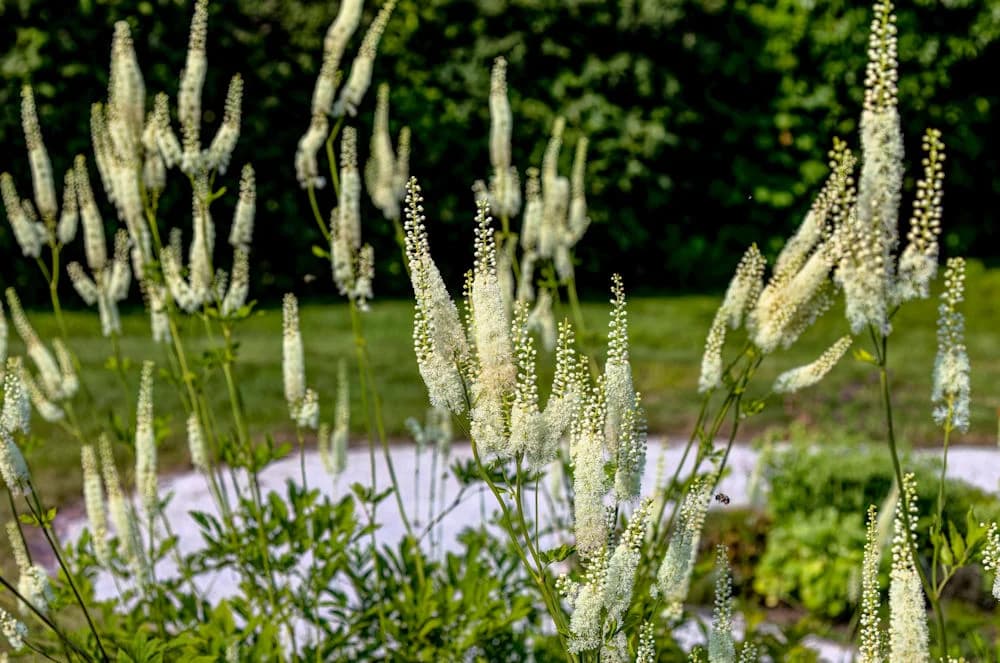
Scientific Name
Actaea racemosa
Common Names
Black Cohosh, Black Snakeroot, Bugbane
Plant Family
Ranunculaceae
Location
Native to the rich, shaded woodlands of Eastern North America — from Ontario to Georgia and westward to Missouri. Prefers damp, loamy soil and partial shade. Found in deciduous forest understories and is now cultivated in herbal gardens and farms for medicinal use.
Description
A tall and elegant perennial herb reaching up to 6 feet when in bloom. The basal leaves are dark green, compound, and deeply lobed, while the tall flowering spikes (racemes) are covered with fluffy white flowers that bloom in mid to late summer. The rootstock is knotty, black, and aromatic. The whole plant has a ghostly beauty in a forest setting.
Uses
Valued as an anti-inflammatory and analgesic herb, long used to ease joint pain, rheumatism, and muscle aches. Its antispasmodic qualities make it especially supportive for menstrual and uterine cramping, while its phytoestrogenic and hormone-modulating actions help relieve menopausal discomforts such as hot flashes, night sweats, mood swings, and nervous tension. Traditionally, it has also been used as a nervine and mild sedative, calming anxiety, insomnia, and tension headaches. The root offers carminative benefits by soothing digestive upset and relieving gas, and it has mild antifungal and expectorant properties that support respiratory health and help loosen congestion. Taken together, Black Cohosh is a versatile remedy for conditions involving pain, inflammation, spasm, and hormonal imbalance, while also lending grounding and calming support to the spirit.
Energetics
Cooling, slightly moistening, bitter, relaxing. Moves energy downward. Calms spasms, tension, and overactivity — physical or emotional. Feels like a weighted blanket over the nervous system.
Parts Used
Root and rhizome (dried)
Constituents
Triterpene glycosides (actein, cimicifugoside), salicylic acid derivatives, resins, isoflavones, isoferulic acid, volatile oils.
Dosage
- Tincture (1:5, 40–50% alcohol): 10–30 drops, 2–3 times daily
- Decoction: ½ tsp dried root per cup water, simmer gently 15–20 minutes (rarely used as tea due to bitterness)
Notes on Use
Black Cohosh is a favored herb for people with physical pain that comes from emotional tension — grief that lodges in the back, hormonal fluctuations that trigger both tears and cramps. It’s especially good for perimenopausal folks who feel unmoored. It can bring a sense of rootedness and calm. Also great in formulas for whiplash or sciatica when there's nerve pain and tension together. It’s not a hormone — it works through the nervous and endocrine systems, gently supporting balance without forcing.
Harvesting
• Root: Harvest in fall once flowering is complete and plant has gone dormant. Roots should be at least 3 years old. Always use cultivated sources — this plant is at risk from overharvesting in the wild.
Contraindications
Avoid during pregnancy (especially early on). Some people experience nausea or headache — often dose-dependent. Caution with estrogen-sensitive conditions or liver issues. Always start low and assess tolerance.
Recipes
- Perimenopause Support Tincture: Black cohosh, vitex, oat tops, motherwort
- Pain + Tension Formula: Black cohosh, skullcap, cramp bark
- Grief Support Elixir: Black cohosh, rose, mimosa, hawthorn